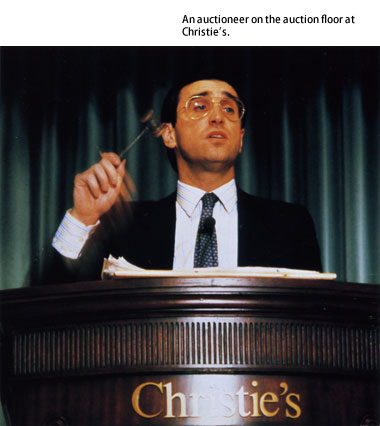
Auctions are thriving in the West. The renowned British auction houses of Sotheby’s established in 1744, and Christie’s, established in 1766, are currently active in the United States and around the world. Most of the items sold are accumulated from the West. And along with paintings, antiques, and furniture, jewelry has become one of the main commodities auctioned. It is not as through the pieces offered date back to ancient Greek or Roman times-most pieces are made in the 20th century, and many are from after World War II or even just a few decades ago. The cycle of jewelry reentering the market is much shorter than one would think.
The auction business represents an important channel for the distribution of gemstones. Besides family heirlooms that are passed down to the next generation, jewelry may be put up for auction to liquidate property, because an heir does not like a piece, or for any number of reasons. In any case, there is an assumed reserve of property. In the West, jewelers may have an estate jewelry department that offers the service of connecting people who wish to sell such jewelry with those who want to buy. These services have increased drastically in the United States since the 1980s, reflection the generation shift and general economic conditions.
In Japan it is often said that there are no places to sell gemstones as in the West, but this observation misses the point. Japan is a market that is still buying gemstones, not yet at the stage of passing down jewelry to the next generation after years of fully enjoying it. The general populace has not yet reached the stage where the stock of gemstones and jewelry is fully saturated. Occasionally I hear suggestions that there should be places where people can sell recently purchased items, but I have doubts about the reasoning behind such an idea.
|

|
I have had several opportunities to participate in the auctions at Christie’s and Sotheby’s, raising my paddle and having my bid accepted. It is often difficult to purchase what you want, since your bid- competing with others from the 200 or so in the auction hall, not to mention numerous advance bids and offers coming in over international long-distance lines- must be the highest.
At times, an item with an estimated price of $10,000, for example, may command three times that amount. Invariably this kind of jewelry fulfills the three requirements of good materials, good design that continues to work in today’s market, and good craftsmanship. If any one of these criteria falls drastically short of expectations, a piece will not be able to meet the estimated price, and the transaction will fail to materialize. Whether the jewelry is to be given to a family member as a gift or sold to a stranger through an intermediary, it must possess all three elements. |
Using diamond as an example, good material does not refer to a color of E or better, a clarity grade of VVS or better, and so forth. The key is high transparency and a well-balanced cut that makes the stone sparkle beautifully. If the color is G or better and the clarity is better than SI1, minor details are not important. GIA grading reports are present at auctions, but generally they accompany only those rate diamonds of over 3 carats. Other than fancy-colored diamonds, stones of less than one carat are not accompanied by a grading report. As for colored stones, Mogok rubies and Kashmir sapphires will be accompanied by a gem identification report to verify the country of origin, issued by a gemological laboratory such as the Gübelin laboratory. Attending an auction is an excellent way for an individual to gain an understanding what constitutes gemstone jewelry that will please generations to come. Auction houses generally charge an intermediary fee of 10 to 15 percent to both the seller and the buyer. |